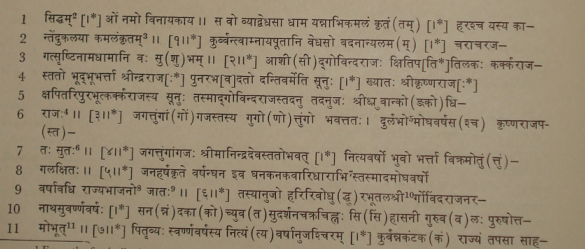|
The Indian Analyst
|
North Indian Inscriptions |
INSCRIPTIONS OF THE SILAHARAS OF NORTH KONKAN
rise. There is thus a discrepancy of one day. It can be reconciled by supposing that though the grant was made on the 25th June A.D. 997, it was actually recorded next day, when the tithi Āshāḍha va. di. 4 was current. ..As for the localities mentioned in the present grant, the donated village Bhādāna still retains its old name and lies about 9 miles, east by north from Bhivaṇḍī. Māhirihāra, the vishaya in which it was included, may be identical with the territorial division of Mahāgirihāra mentioned in the Anjanēri plates (First Set) of the Hariśchandrīya king Bhōgaśakti. The place from which it derived its name may be identical with Murhe, about three miles northwest of Paḍaghe. The latter is identical with Paḍigaha mentioned in the present grant as marking the northern boundary of the donated village Bhādāna. The river Kumbhārī, which flowed on the east, is still known by its ancient name. Kielhorn identified the great river Murulā with the Ulhāsa, but the latter flows at a distance of six miles. This identification seems, therefore, unlikely. The Murulā is more probably the river Bhatsāvī, which flows only about a mile south of Bhādāna and is joined by the Kumbhārī. The village Āsachchhadī, which formed the western boundary of Bhādāna, has gone out of existence. Its old site is now occupied by the village Talaul, which lies only a mile to the west Bhādāna. Guṇapura cannot now be traced in the vicinity of Bhādāna. Lavaṇētaṭa, where the temple of the Sun was situated, is the modern village Loṇāḍ, six miles south-east of Bhivaṇḍī, where there are many ruins of ancient temples. Sthānaka, the capital of the Śilāhāras, is of course modern Ṭhāṇā, a station on the Kalyaṇ-Bombay line of the Central Railway.
TEXT[1]
[1] From the facsimiles in Ep. Ind., Vol. III, facing pp. 272, 273 and 276.
|
|||||||||||||||||||||||||||||||||||||||||||||||||||||||||||||||||||||||||||||||||||||||||||||||||||||||||||||||||||||
| > |
|
>
|








